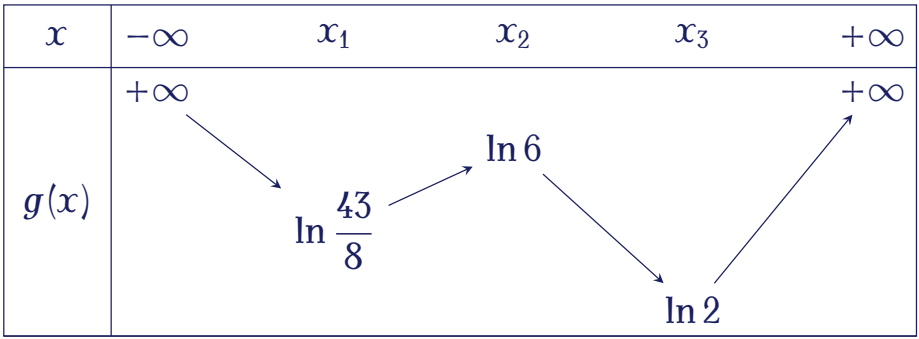Tích phân \(\displaystyle\int\limits_0^13^{2x+1}\mathrm{\,d}x\) bằng
| \(\dfrac{27}{\ln9}\) | |
| \(\dfrac{9}{\ln9}\) | |
| \(\dfrac{4}{\ln3}\) | |
| \(\dfrac{12}{\ln3}\) |
Tích phân $\displaystyle\displaystyle\int\limits_{0}^{10}x\mathrm{e}^{30x}\mathrm{\,d}x$ bằng
| $\dfrac{1}{900}\left(299\mathrm{e}^{300}+1\right)$ | |
| $300-900\mathrm{e}^{300}$ | |
| $-300+900\mathrm{e}^{300}$ | |
| $\dfrac{1}{900}\left(299\mathrm{e}^{300}-1\right)$ |
Tính tích phân $I=\displaystyle\displaystyle\int\limits_{0}^{1}\left(3x^2+\mathrm{e}^x+\dfrac{1}{x+1}\right)\mathrm{d}x$.
Biết $\displaystyle\displaystyle\int\limits_{-1}^1\left(\dfrac{9}{x-3}-\dfrac{7}{x-2}\right)\mathrm{\,d}x=a\ln{3}-b\ln{2}$. Tính giá trị $P=a^2+b^2$.
| $P=32$ | |
| $P=130$ | |
| $P=2$ | |
| $P=16$ |
Biết $\displaystyle\displaystyle\int\limits_{0}^{2}(3x-1)\mathrm{e}^{\tfrac{x}{2}}\mathrm{\,d}x=a+b\mathrm{e}$ với $a,\,b$ là các số nguyên. Giá trị của $a+b$ bằng
| $12$ | |
| $16$ | |
| $6$ | |
| $10$ |
Giả sử tích phân \(I=\displaystyle\int\limits_{1}^{6}\dfrac{1}{2x+1}\mathrm{\,d}x=\ln M\), tìm \(M\).
| \(M=13\) | |
| \(M=4,33\) | |
| \(M=\sqrt{\dfrac{13}{3}}\) | |
| \(M=\dfrac{13}{3}\) |
Biết rằng \(\displaystyle\int\limits_{1}^{5}\dfrac{1}{2x-1}\mathrm{\,d}x=\ln a\). Giá trị của \(a\) là
| \(81\) | |
| \(27\) | |
| \(3\) | |
| \(9\) |
Tìm đạo hàm của hàm số \(y=\ln\left(1+\mathrm{e}^{2x}\right)\).
| \(y'=\dfrac{-2\mathrm{e}^{2x}}{\left(1+\mathrm{e}^{2x}\right)^2}\) | |
| \(y'=\dfrac{\mathrm{e}^{2x}}{1+\mathrm{e}^{2x}}\) | |
| \(y'=\dfrac{1}{1+\mathrm{e}^{2x}}\) | |
| \(y'=\dfrac{2\mathrm{e}^{2x}}{1+\mathrm{e}^{2x}}\) |
Tính tích phân \(I=\displaystyle\int\limits_0^{\tfrac{\pi}{2}}\left(\sin{2x}+\sin x\right)\mathrm{\,d}x\).
| \(5\) | |
| \(3\) | |
| \(4\) | |
| \(2\) |
Tích phân \(\displaystyle\int\limits_1^2\dfrac{\mathrm{\,d}x}{2x+1}\) bằng
| \(\log\dfrac{5}{3}\) | |
| \(\dfrac{2}{15}\) | |
| \(\dfrac{1}{2}\ln\dfrac{5}{3}\) | |
| \(\dfrac{16}{225}\) |
Cho hàm số \(y=f(x)\) liên tục, luôn dương trên \([0;3]\) và thỏa mãn \(I=\displaystyle\int\limits_0^3 f(x)\mathrm{\,d}x=4\). Khi đó giá trị của tích phân \(K=\displaystyle\int\limits_0^3 (\mathrm{e}^{1+\ln f(x)}+4)\mathrm{\,d}x\) là
| \(14+3\mathrm{e}\) | |
| \(4\mathrm{e}+14\) | |
| \(12+4\mathrm{e}\) | |
| \(3\mathrm{e}+12\) |
Đạo hàm của hàm số $y=\ln\big(x^2+2\big)$ là
| $y'=\dfrac{1}{x^2+2}$ | |
| $y'=\dfrac{x}{x^2+2}$ | |
| $y'=\dfrac{2}{x^2+2}$ | |
| $y'=\dfrac{2x}{x^2+2}$ |
Cho hàm số $f(x)$ liên tục trên $\mathbb{R}$. Gọi $F(x)$ và $G(x)$ là hai nguyên hàm của $f(x)$ thỏa mãn $2F(3)+G(3)=9+2F(-1)+G(-1)$. Khi đó $\displaystyle\displaystyle\int\limits_0^2\big(x^2+f(3-2x)\big)\mathrm{\,d}x$ bằng
| $\dfrac{25}{6}$ | |
| $\dfrac{7}{6}$ | |
| $\dfrac{43}{6}$ | |
| $3$ |
Tính tích phân $\displaystyle\int\limits_{0}^{1}(2x+1)^5\mathrm{\,d}x$.
$\lim\limits_{x\to0}\dfrac{\mathrm{e}^x-1}{3x}$ bằng
| $0$ | |
| $1$ | |
| $3$ | |
| $\dfrac{1}{3}$ |
Đạo hàm của hàm số $y=\dfrac{\ln2x}{x}$ là
| $y'=\dfrac{1-\ln2x}{x^2}$ | |
| $y'=\dfrac{\ln2x}{2x}$ | |
| $y'=\dfrac{\ln2x}{x^2}$ | |
| $y'=\dfrac{1}{2x}$ |
Cho hàm số bậc bốn $y=f(x)$. Biết rằng hàm số $g(x)=\ln f(x)$ có bảng biến thiên như sau:

Diện tích hình phẳng giới hạn bởi các đường $y=f'(x)$ và $y=g'(x)$ thuộc khoảng nào dưới đây?
| $(5;6)$ | |
| $(4;5)$ | |
| $(2;3)$ | |
| $(3;4)$ |
Xét tích phân $I=\displaystyle\displaystyle\int\limits_1^{\rm{e}^2}\dfrac{\left(1+2\ln x\right)^2}{x}\mathrm{\,d}x$, nếu đặt $t=1+2\ln{x}$ thì $I$ bằng
| $\dfrac{1}{2}\displaystyle\displaystyle\int\limits_1^{e^2}t^2\mathrm{\,d}t$ | |
| $2\displaystyle\displaystyle\int\limits_1^5t^2\mathrm{\,d}t$ | |
| $2\displaystyle\displaystyle\int\limits_1^{e^2}t^2\mathrm{\,d}t$ | |
| $\dfrac{1}{2}\displaystyle\displaystyle\int\limits_1^5t^2\mathrm{\,d}t$ |
Cho hàm số $f(x)$ xác định trên $\mathbb{R}\setminus\{1\}$ thỏa mãn $f^{\prime}(x)=\dfrac{1}{x-1}$, $f(3)=2021$. Tính $f(5)$.
| $f(5)=2020-\dfrac{1}{2}\ln2$ | |
| $f(5)=2021-\ln2$ | |
| $f(5)=2021+\ln2$ | |
| $f(5)=2020+\ln2$ |
Cho hàm số $f(x)$ liên tục trên $\mathbb{R}$ thỏa $\displaystyle\displaystyle\int\limits_{0}^{1}f(x)\mathrm{d}x=2$ và $\displaystyle\displaystyle\int\limits_{0}^2f(3x+1)\mathrm{d}x=6$. Tính $I=\displaystyle\displaystyle\int\limits_{0}^{7}f(x)\mathrm{d}x$.
| $I=20$ | |
| $I=8$ | |
| $I=18$ | |
| $I=16$ |
